Samsung Galaxy S 5 Review
by Anand Lal Shimpi & Joshua Ho on April 8, 2014 12:00 AM EST- Posted in
- Smartphones
- Samsung
- Mobile
- Galaxy S 5
CPU Performance
The Galaxy S 5 marks the second Snapdragon 801 based device we've reviewed at AnandTech, the first being HTC's M8. I've gone through the Snapdragon 801 in depth already, but we're basically dealing with a reasonable upgrade to Snapdragon 800 on an improved 28nm HPm process. The bulk of the improvements impact GPU and ISP performance, but the SoC is just better overall. GS5 owners are lucky as all versions of the device that use Qualcomm silicon feature the MSM8974AC v3 SKU, which includes four 2.5GHz Krait 400 cores and a 578MHz Adreno 330 GPU.
| Snapdragon 800/801 Breakdown | ||||||||||
| SoC Version | Model | Max CPU Frequency | Max GPU Frequency | ISP | eMMC | DSDA | Memory IF | |||
| MSM8974VV | v2 | S800 | 2.2GHz | 450MHz | 320MHz | 4.5 | N | 800MHz | ||
| MSM8974AA | v2 | S800 | 2.3GHz | 450MHz | 320MHz | 4.5 | N | 800MHz | ||
| MSM8974AB | v2 | S800 | 2.3GHz | 550MHz | 320MHz | 4.5 | N | 933MHz | ||
| MSM8974AA | v3 | S801 | 2.3GHz | 450MHz | 320MHz | 5.0 | Y | 800MHz | ||
| MSM8974AB | v3 | S801 | 2.3GHz | 578MHz | 465MHz | 5.0 | Y | 933MHz | ||
| MSM8974AC | v3 | S801 | 2.5GHz | 578MHz | 465MHz | 5.0 | Y | 933MHz | ||
Although Samsung was the first major OEM to be caught cheating in Android benchmarks, it appears to have completely abandoned the practice with the Galaxy S 5's shipping software. Not only was I unable to find any evidence of the old cheats, I couldn't find any evidence of HTC's new subtle cheating either. The Galaxy S 5 appears to be clean as far as I can tell. Kudos to Samsung on doing the right thing, and I hope all other OEMs take this as a sign to stop the silliness.
For our performance tests I turned to our usual suite of browser and native applications. If there's one obvious takeaway from our CPU tests it's that despite having faster silicon than HTC's M8, the GS5 isn't always faster. I believe this has more to do with thermals than anything else. HTC's metal chassis is able to do a better job of dissipating heat than the GS5's plastic chassis. I don't believe there's a substantial impact on user experience, but it's interesting to note how choice in materials can have a performance impact like this.
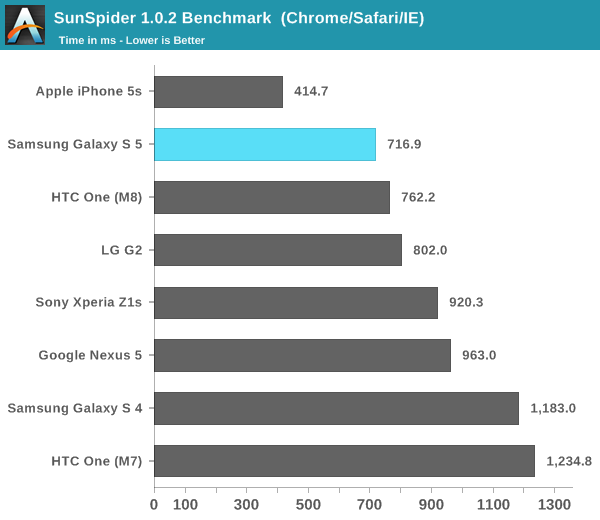
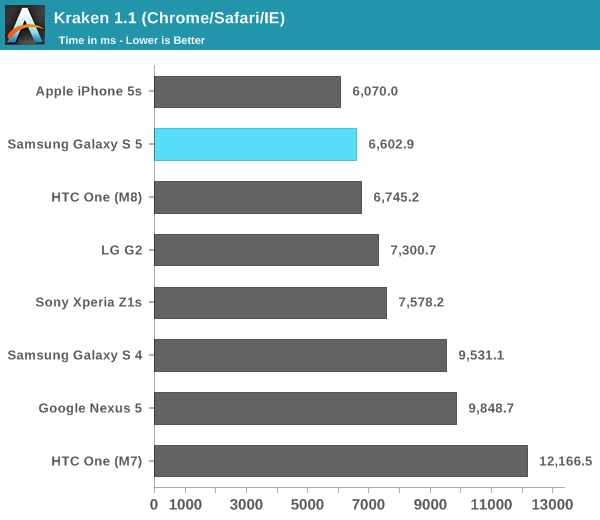
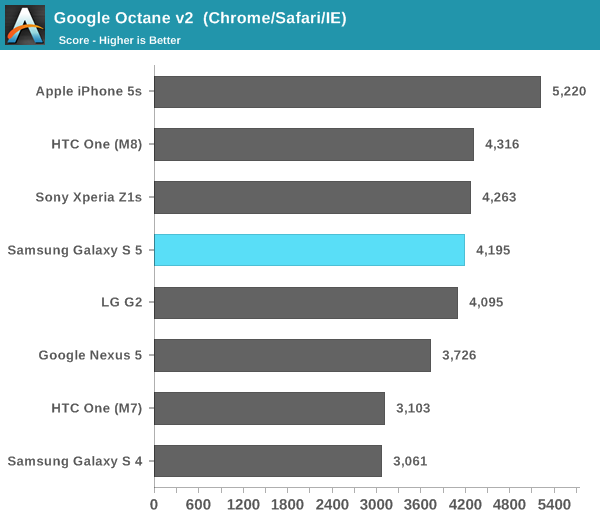
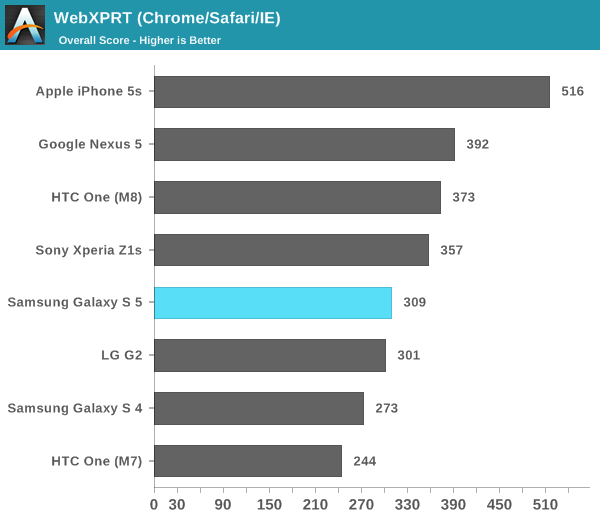
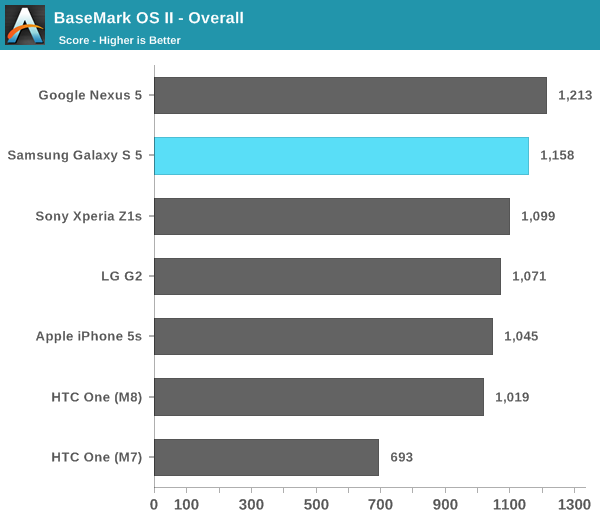
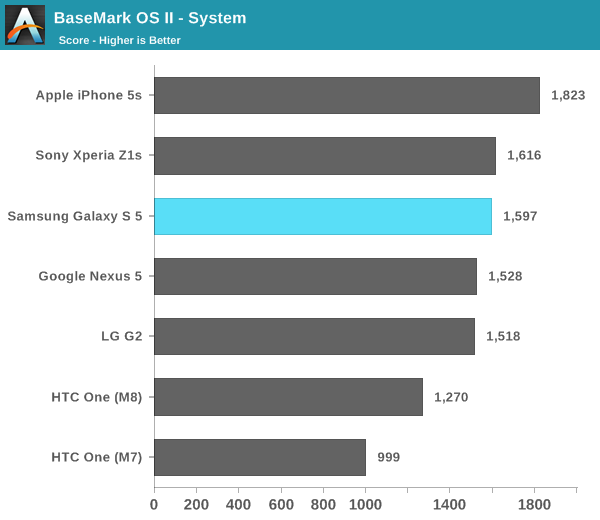
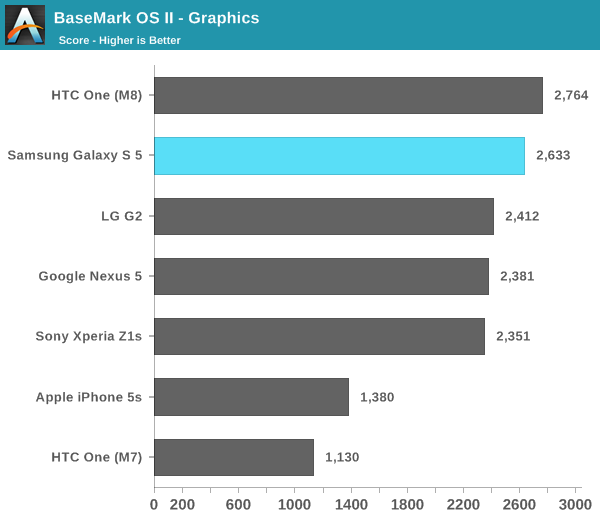

GPU Performance
GPU performance remains where we see the biggest benefit from Snapdragon 801 vs. 800, and since the GPU gains are almost entirely due to frequency scaling it's not too surprising that the M8 pulls ahead of the GS5 here in most cases.
There aren't any surprises here. The Adreno 330 in the Galaxy S 5 is more than capable of driving the device's 1080p display both in current and near term future 3D games.
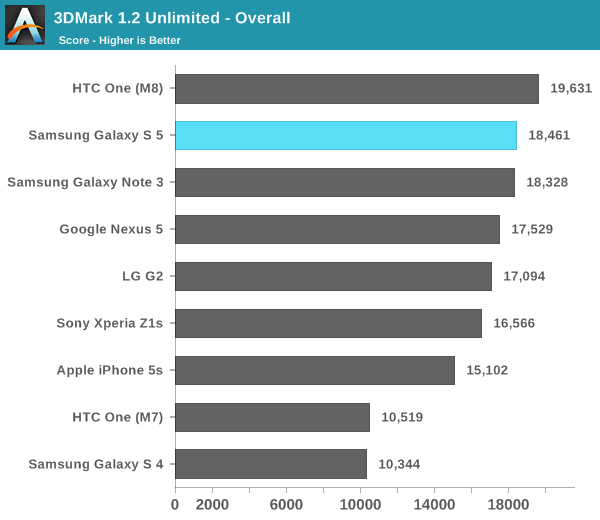
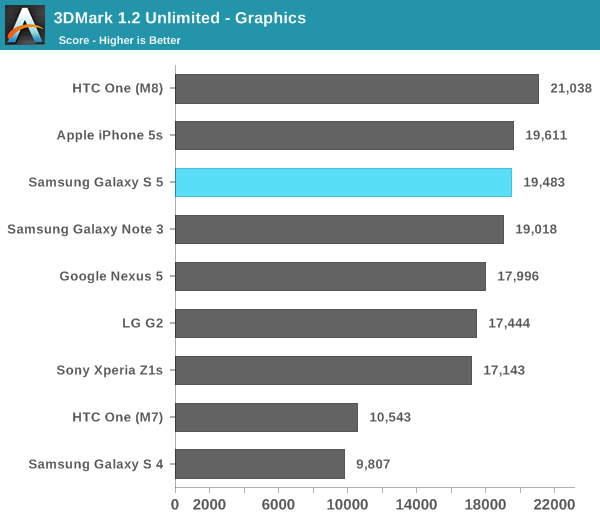
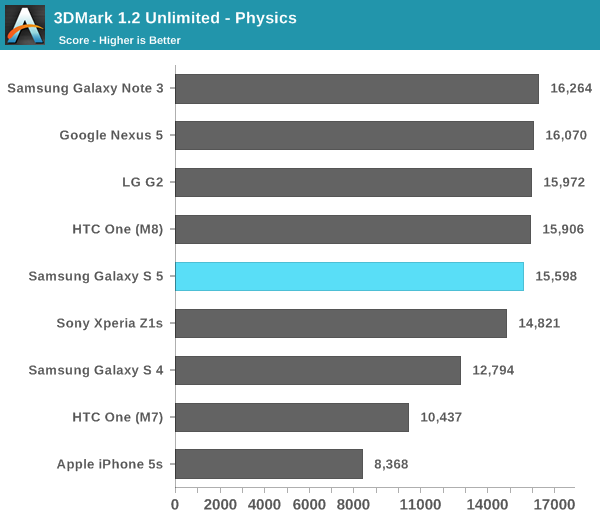
BaseMark X 1.1
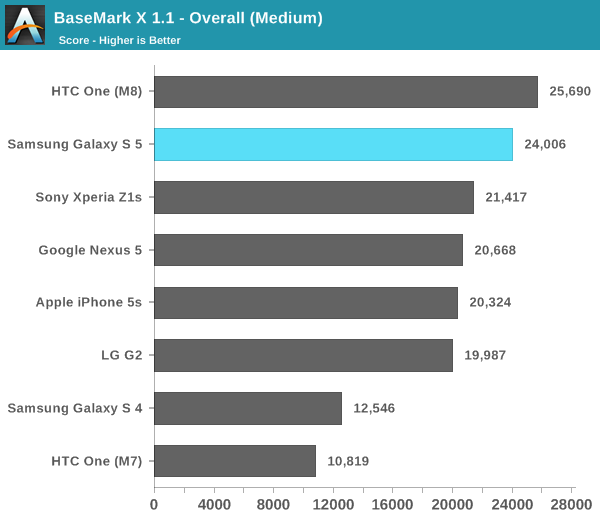

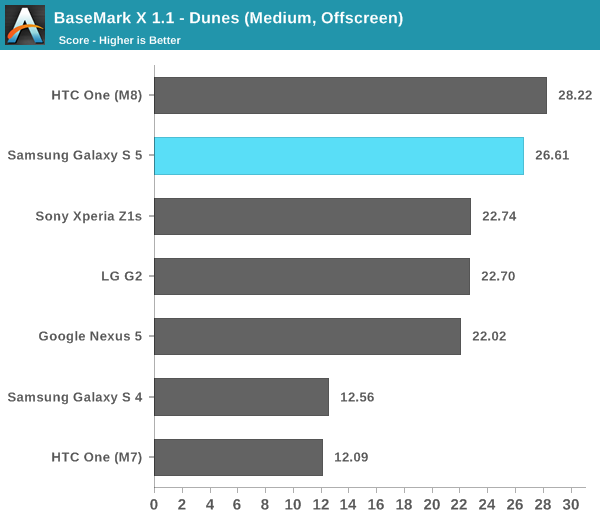
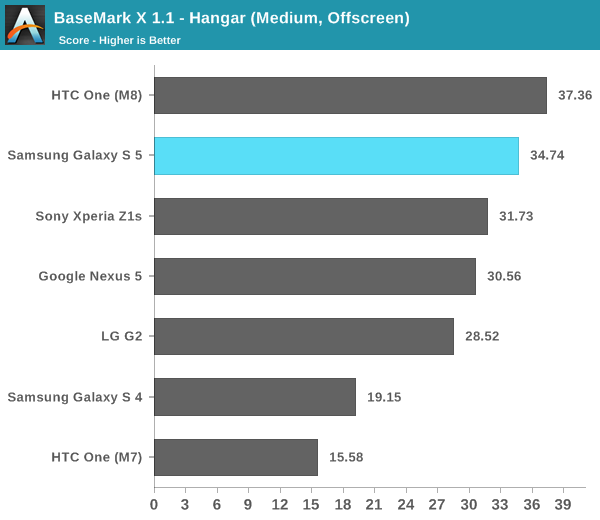

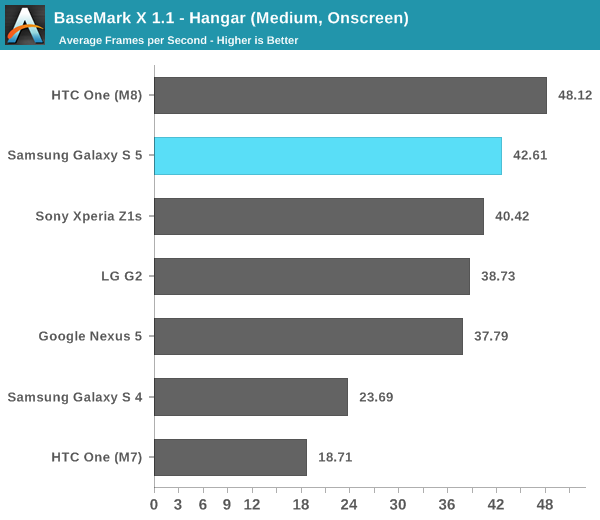
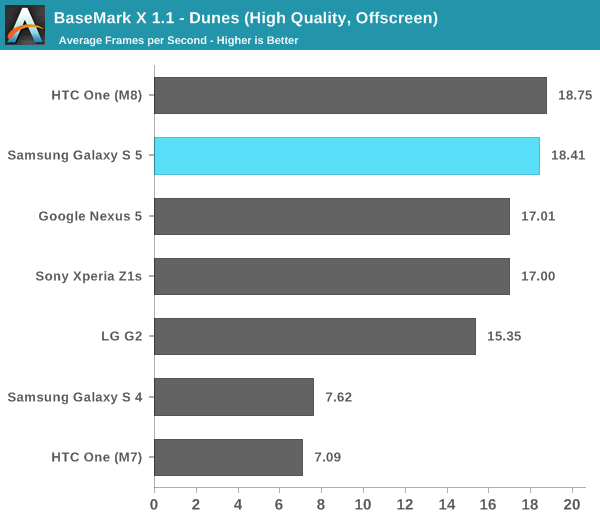
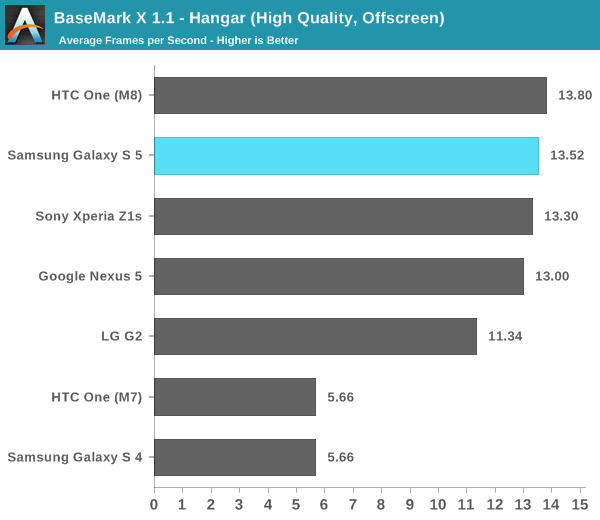
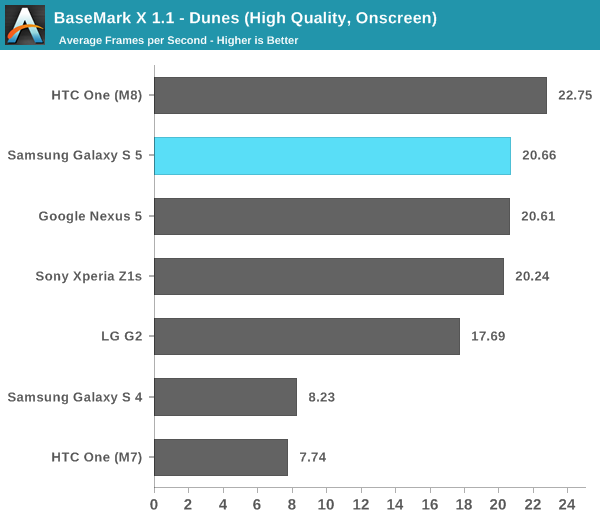
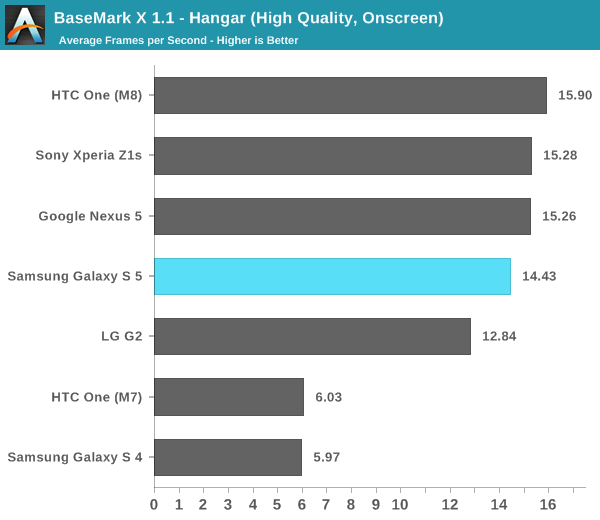
GFXBench 3.0
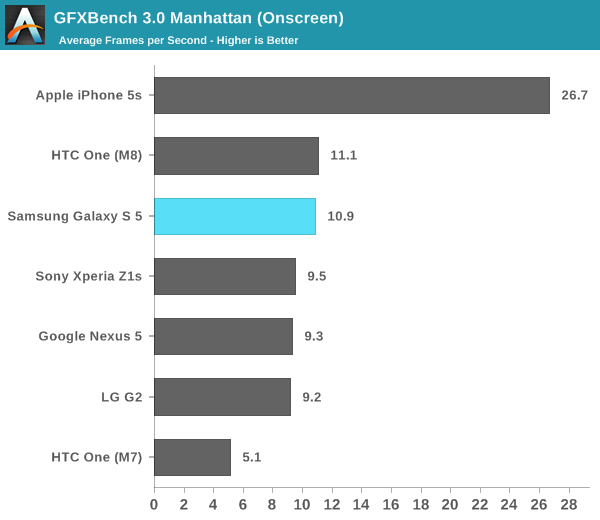
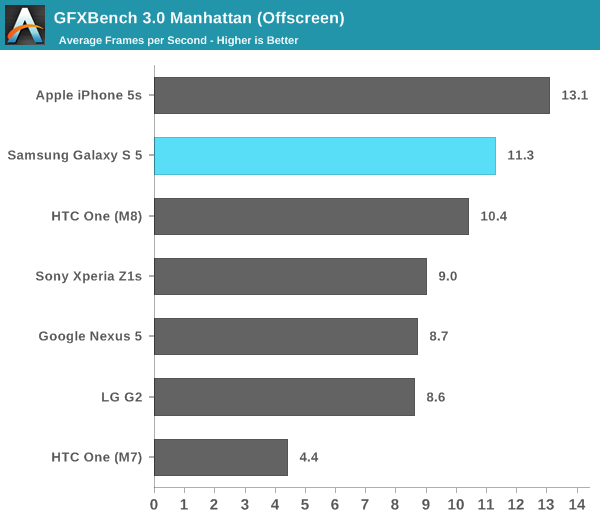
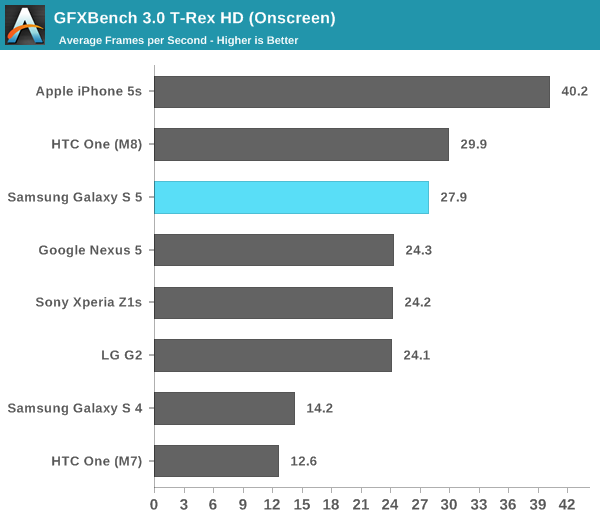
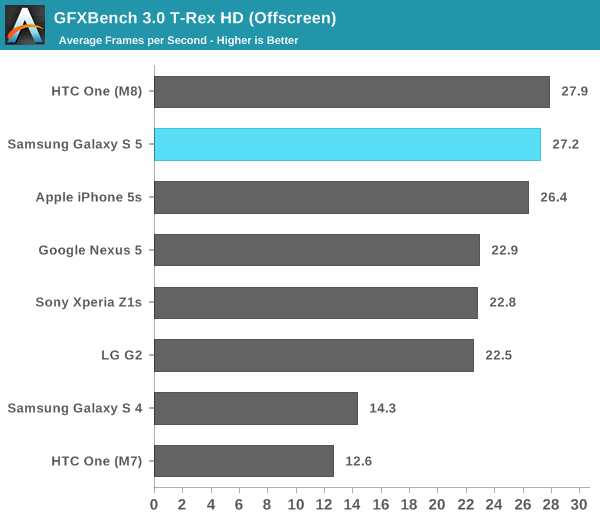

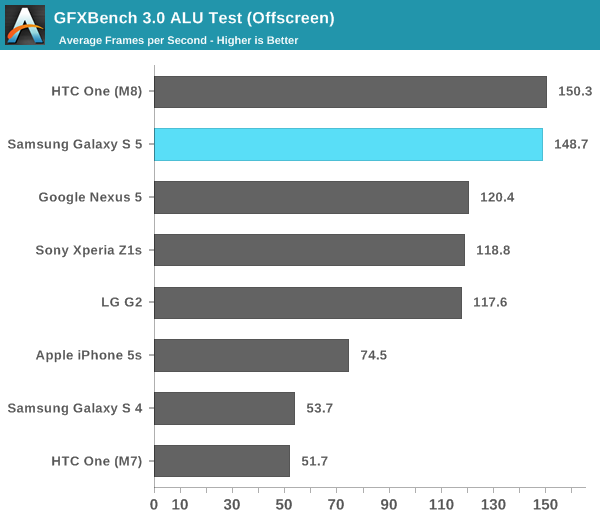


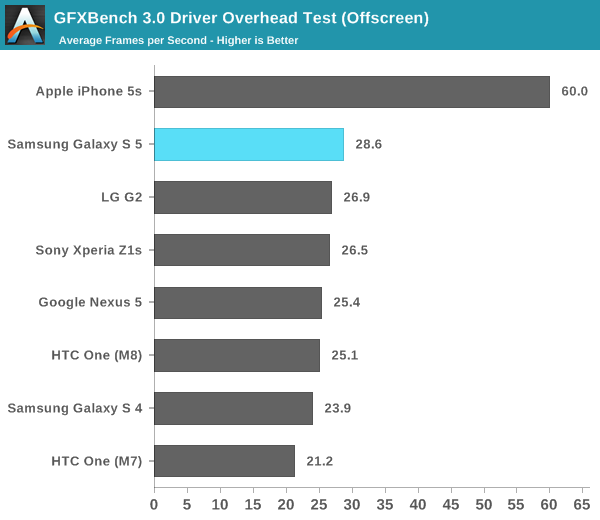
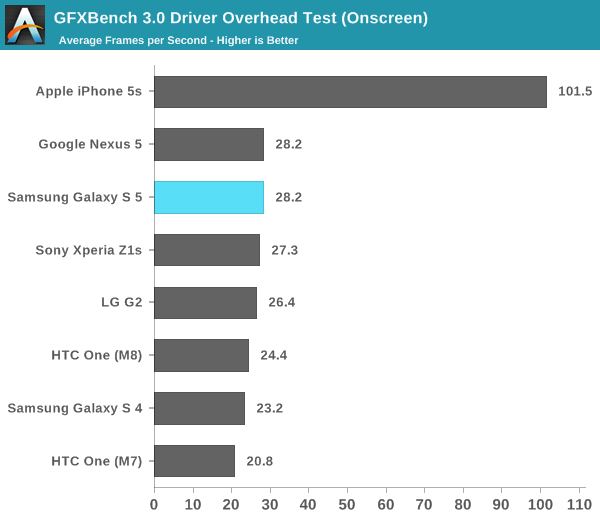
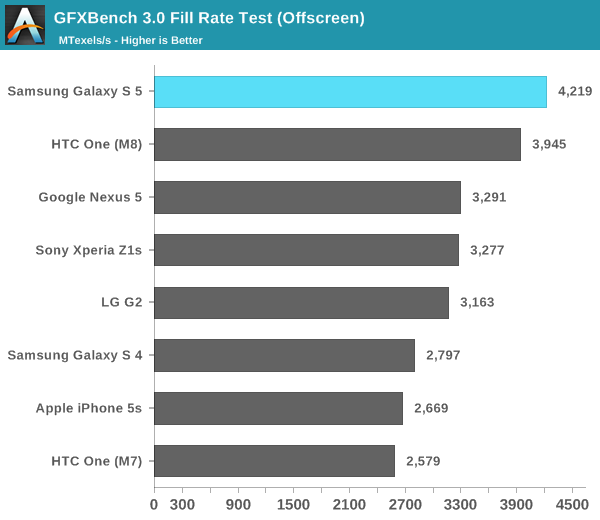
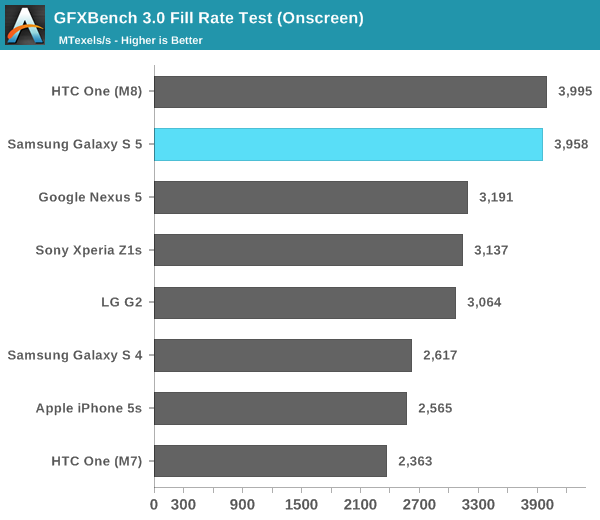
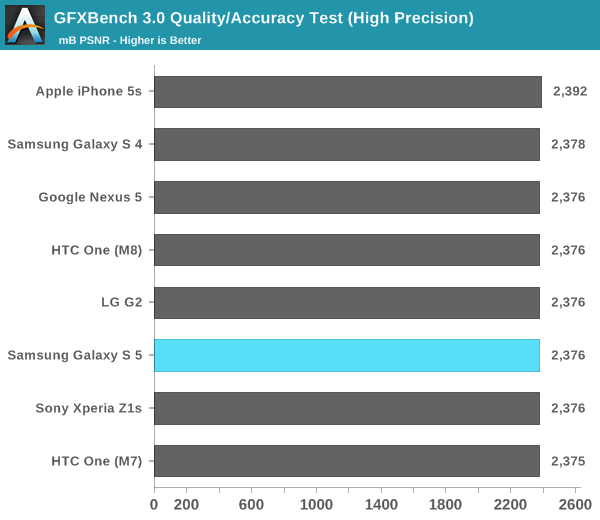
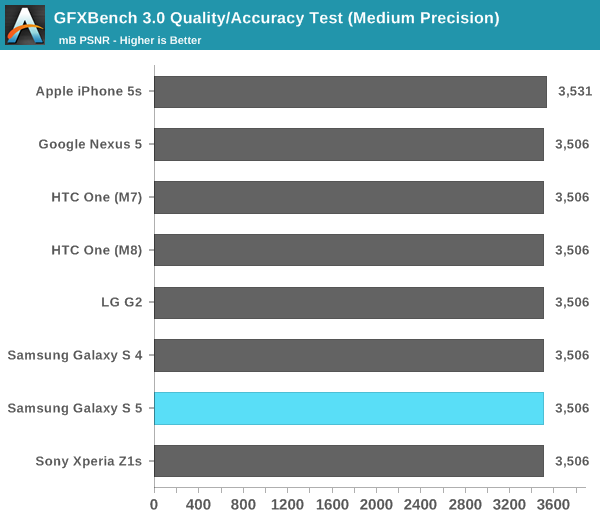
NAND Performance
The GS5 ships with 16GB or 32GB of NAND internally on an integrated eMMC device. Expansion is supported through a microSD card slot behind the removable back cover. Although the Snapdragon 801 inside supports eMMC 5.0, that alone doesn't guarantee a substantial increase in NAND performance. Keep in mind that most OEMs find multiple sources for their internal eMMC/NAND solutions, so what I'm testing here may only be representative of a portion of all GS5 devices.
Samsung sampled a 16GB GS5 review device. I put it through our usual random/sequential IO tests on a 100MB span of LBAs.
Random read performance is disappointing, it falls behind all modern devices we've tested. Random write performance is middle-of-the-road at best. It's unclear to me if this is a cost optimization or a lack of concern for NAND performance, but either way I'd rather see these metrics improve rather than regress.
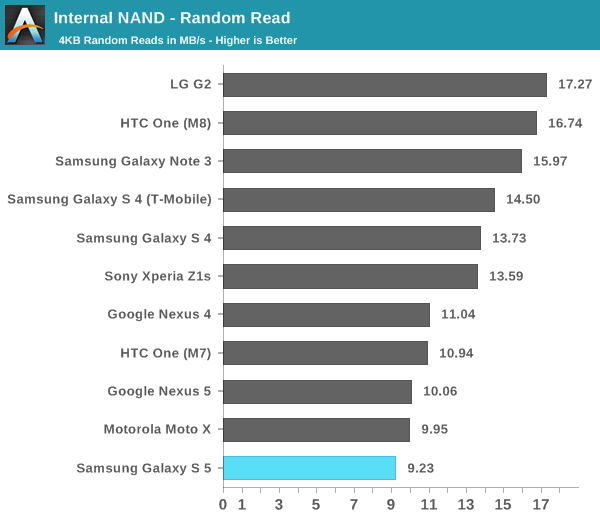
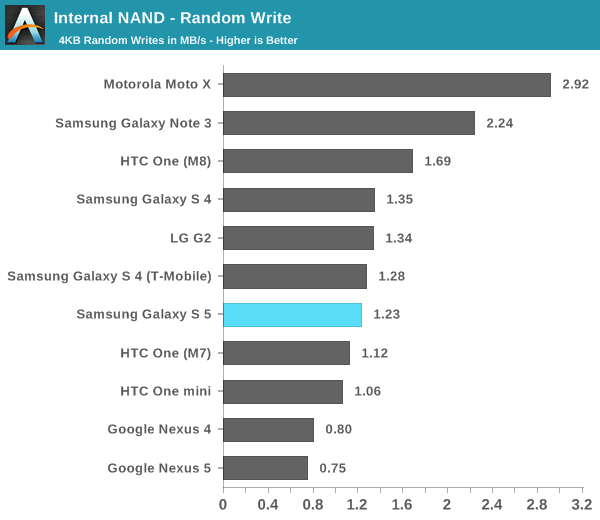
Sequential read/write performance both improve handsomely compared to the Galaxy S 4. I can see why Samsung would want to optimize for these two cases as they are quite common in regular usage, but random read/write performance can also significantly impact user experience.
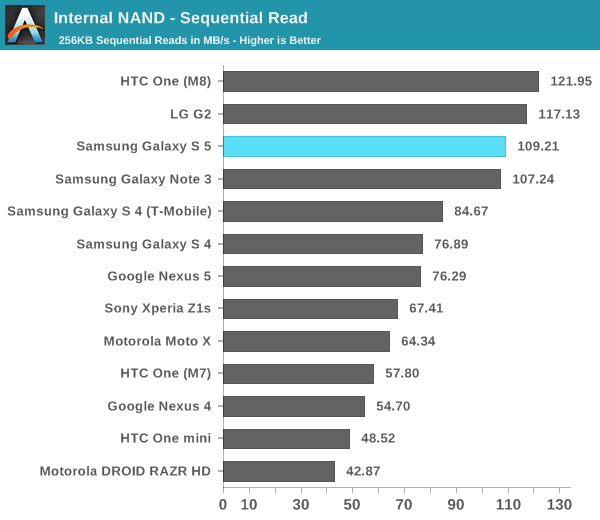
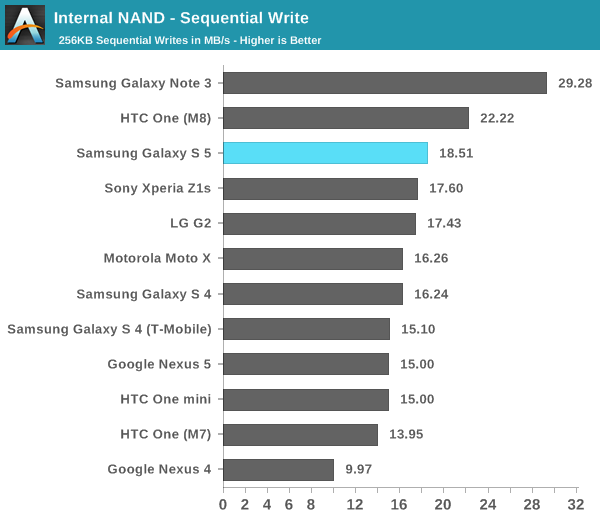










296 Comments
View All Comments
doobydoo - Friday, April 11, 2014 - link
'The 64-bit thing is totally overblown'Just wondering if you actually read this website or not...
tipoo - Friday, April 11, 2014 - link
Yes, you're wrong. It's not like when 64 bit Android drops all 32 bit will be deprecated. Both will still be supported for a long ass time. In fact it may take a long time for 64 bit apps to come around.cknobman - Tuesday, April 8, 2014 - link
Eh, my family is done with Samsung phones.After my wife owning a GS3 my self owning the GS4 we have plenty of experience with their products and both agree we dont want another one.
When people used to say Samsung made cheap phones we thought that was blown out of proportion. WE WERE WRONG.
Samsung Galaxy phones are cheap plastic crap. The screens break too easily. My wife has had her screen shatter 3 times and every single time the phone was in a case. I used to drop my HTC evo on the cement without a case and it had nothing but a scratch/dent.
Next upgrade will likely be to the new HTC One M8 or maybe an LG G2. I bought my son and LG G2 for Christmas and have been jealous ever since. Everything about that phones design trumps the Samsung Galaxy phones, even the software.
What I would really like to get my hands on is a Nokia Lumia 930. I was able to play with these at a private Nokia party during Microsoft Build this year and let me tell you this phone is absolutely amazing. Some of the software features on it are going to make all other phones pale in comparison. They had side by side demos of the 930, iPhone 5S, SGS4 and some of the things the 930 could do were amazing.
Duraz0rz - Tuesday, April 8, 2014 - link
"What I would really like to get my hands on is a Nokia Lumia 930. I was able to play with these at a private Nokia party during Microsoft Build this year and let me tell you this phone is absolutely amazing. Some of the software features on it are going to make all other phones pale in comparison. They had side by side demos of the 930, iPhone 5S, SGS4 and some of the things the 930 could do were amazing."Unfortunately, the Lumia 930 won't be coming states-side anytime soon. The Nokia flagships for the time being will be the 1520 on AT&T or the Icon (which is essentially the same as the 930) on Verizon.
cknobman - Tuesday, April 8, 2014 - link
At build mr elop presented the phone himself saying US availability would be June 2 (give or take a week).kyuu - Tuesday, April 8, 2014 - link
Are you sure he wasn't talking about EU availability?mmsmsy - Tuesday, April 8, 2014 - link
LG G2 still is smaller, has bigger screen, bigger battery and nearly the same performance as GS5 at incredibly lower price. This GS is a shame compared to half year old LG.kaelynthedove78 - Tuesday, April 8, 2014 - link
For comparison, here are the NAND 256k sequential speeds for a couple of iPhones:4S (32GB model): 54,2MB/s read, 21,2MB/s write.
5S (16GB model): 164MB/s read, 39,8MB/s write.
Measured with dd, file caching disabled and circa 2,5GB files.
kyuu - Tuesday, April 8, 2014 - link
1) How did you measure NAND performance on an iPhone?2) Sequential measurements aren't interesting. The random performance is what differentiates good NAND from bad.
twebber - Tuesday, April 8, 2014 - link
I love the galaxy, I hate apple, but I will not buy another phone that uses micro usb plug. If this means I have to buy an apple, which KILLS me inside to say, I will.